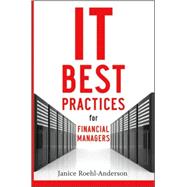
Note: Supplemental materials are not guaranteed with Rental or Used book purchases.
Purchase Benefits
What is included with this book?
Acknowledgments.
About the Contributors.
PART I THE BASICS.
CHAPTER 1 The Information Technology Planning Process.
Finance and Information Systems.
Information Technology Planning Process.
The Role of Finance in the Systems Planning Process.
Conclusion.
CHAPTER 2 ERP Software Selection.
Project Preparation, Scope Definition and Approach.
Vendor Candidate Identification and Short Listing.
Request for Information/Request for Proposal Analysis, Vendor Demonstrations, and References.
Preliminary Vendor Recommendation and Negotiations.
Final Vendor Decision and Procurement.
Conclusion.
CHAPTER 3 The Software Implementation Process.
Key Implementation Concepts.
The Implementation Phases in Detail.
Common Risks and Mitigation Strategies.
Areas that Require Special Attention from the CFO.
Conclusion.
CHAPTER 4 Critical Success Factors for IT Implementations.
Provide Effective Sponsorship.
Select a Dedicated and Experienced Project Team.
Establish Project Infrastructure.
Utilize a Well-Established Approach.
Address People Issues.
Communicate.
Manage Scope.
Establish a Supportive Culture.
Conduct Periodic Quality Assurance Reviews.
Provide a Stable Technical Environment.
Conclusion.
CHAPTER 5 Steering Clear of a “Crisis in Confidence” and Other People Pitfalls.
Phase 1: Before the Project.
Phase 2: During the Project.
Phase 3: After the Project.
Conclusion.
CHAPTER 6 Objectives and Scope of Implementing Automated Financial Systems.
Objectives.
Core (First-Tier) Applications.
Second-Tier Applications.
Tier Two Applications.
Third-Tier Applications and Beyond.
Conclusion.
PART II IT HOT TOPICS.
CHAPTER 7 Shared Services and Financial Systems.
Creating Value through Financial Systems-Enabled Shared Services.
Financial Systems as a Foundation for Shared Services Benefits Realization.
SSC and Financial Systems Implementation Considerations.
Financial Executive’s Role in Shared Services Implementations.
Conclusion.
CHAPTER 8 Globalization Trends in Offshore Information Technology.
How Is Global IT Different from Offshore IT?
How Globalization of Business Has Influenced Global IT.
How Pervasive IT Influenced Global IT.
How Global IT Continues to Drive Changes in Globalized Business.
Conclusion.
CHAPTER 9 Security, Controls, and Privacy.
Impact of Sarbanes-Oxley on Financial System Implementations.
Financial Executive’s Role in the Security, Controls, and Privacy Area.
Security, Control, and Privacy Safeguard Design.
Controls Automation.
Ways to Test Controls.
Conclusion.
CHAPTER 10 What Is IFRS and Why Is It Relevant to the CFO Now?
History and Specifics of IFRS.
Some Key Differences between IFRS and U.S. GAAP.
Potential Benefits of Reporting under IFRS.
Potential “Costs” or Cons of Reporting under IFRS.
The Decision to Move to IFRS.
IFRS Conversion Project Approach.
Conclusion.
Notes.
CHAPTER 11 The Phenomenon of Software as a Service.
Background: What Is SaaS?
The Value Proposition of SaaS.
Making the Right Decision: Is SaaS Right for Me?
Implications to IT Organizations.
Conclusion.
CHAPTER 12 Investing in Product Information Management.
Overview.
PIM Adaptation Catalysts.
PIM Implementation Considerations.
PIM Return on Investment.
Conclusion.
Note.
CHAPTER 13 E-Commerce.
E-Commerce Defined.
E-Commerce Today.
Increasing Shareholder Value.
Justifying the Investment.
Implementing Financial Controls for E-Commerce.
Conclusion.
CHAPTER 14 ERP: An Evolving Process.
Getting Started.
You Have Identified the Problem, Now You Need to Define the Solution.
Conclusion.
PART III MERGERS, ACQUISITIONS, DIVESTITURES, AND IT.
CHAPTER 15 Key IT-Related Questions Every Financial Executive Should Consider during a Merger, Acquisition, or Divestiture.
Before a Transaction Is Identified.
After a Transaction Is Identified.
Conclusion.
Notes.
CHAPTER 16 The Importance of IT Due Diligence during a Merger or Acquisition.
Why Bother With IT Due Diligence?
Role of the Chief Information Officer.
Looking Under the Hood: Your IT Due Diligence Checklist.
How to Get the Data?
Beyond Cost Reduction: Identifying IT Synergies.
Accelerating Merger Integration Planning through Due Diligence.
Due Diligence after the Close.
Conclusion.
CHAPTER 17 Ways to Enhance IT-Related Synergy Capture during a Merger, Acquisition, or Divestiture.
Sources of IT Synergies.
Benchmarks to Establish IT Synergy Targets.
Begin Early and Build Momentum.
Conclusion.
CHAPTER 18 Ways to Reduce IT-Related Costs during a Merger, Acquisition, or Divestiture.
Approach.
Cost Reduction during Merger or Acquisition.
Cost Reduction during Divesture.
Conclusion.
CHAPTER 19 Effective Approaches for Managing IT during a Merger, Acquisition, or Divestiture.
New Terminology.
Faster Pace.
New Challenges for IT.
Conclusion.
CHAPTER 20 Ways to Use Mergers, Acquisitions, or Divestitures to Build Sustainable Information Technology Value.
Divestitures to Build Sustainable Information Technology Value.
Conclusion.
CHAPTER 21 Time-Tested Approaches to Maintaining Data Integrity during a Merger, Acquisition, or Divestiture.
Potential Impacts of Poor-Quality Data.
Time-Tested Approaches to Help Maintain the Integrity of the Data.
Conclusion.
Glossary.
About the Author.
Index.
The New copy of this book will include any supplemental materials advertised. Please check the title of the book to determine if it should include any access cards, study guides, lab manuals, CDs, etc.
The Used, Rental and eBook copies of this book are not guaranteed to include any supplemental materials. Typically, only the book itself is included. This is true even if the title states it includes any access cards, study guides, lab manuals, CDs, etc.